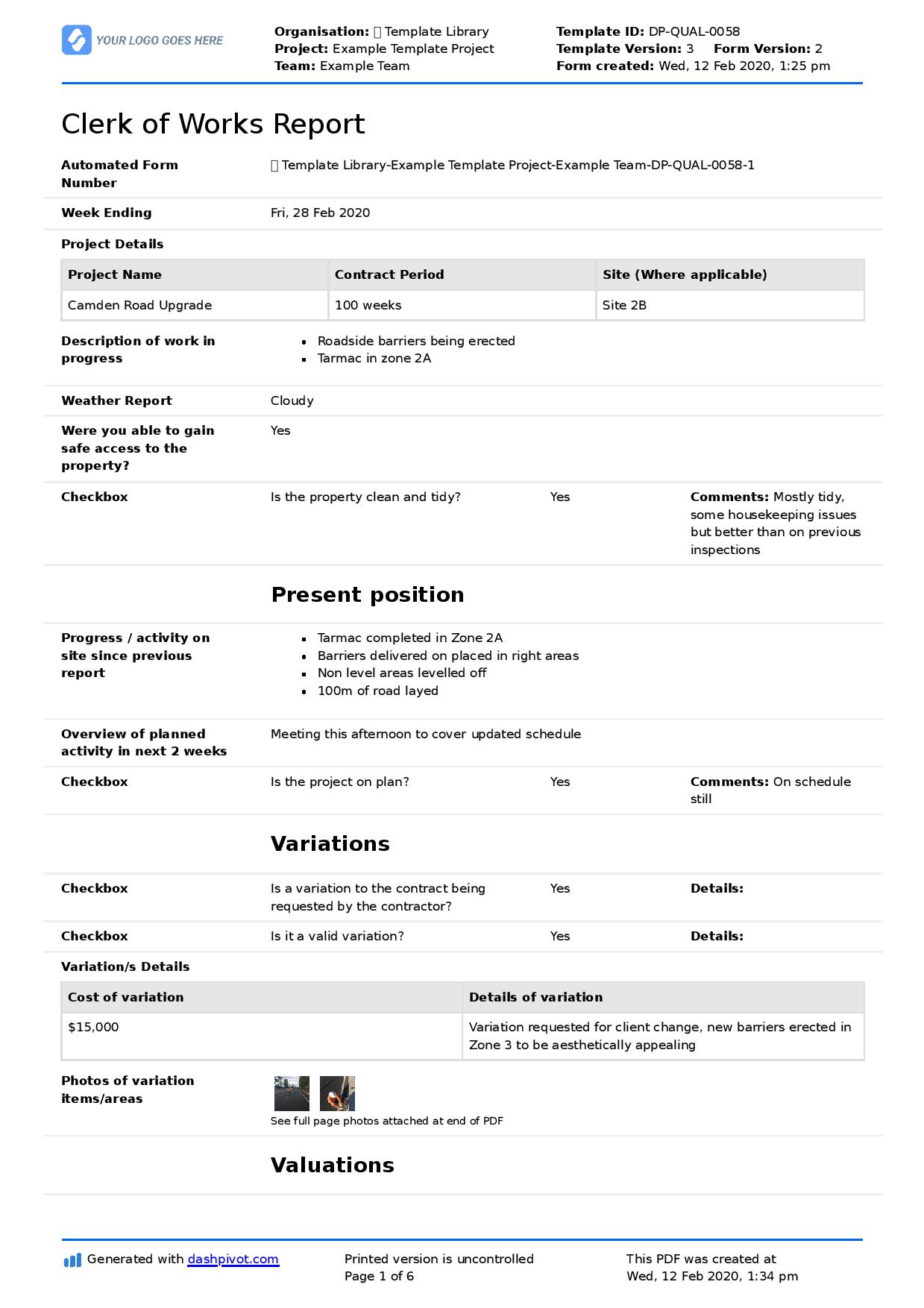Dashpivot article – How to become a clerk of works
How to become a Clerk of Works
Read this comprehensive guide to understand how to become a clerk of works, and get access to some free and proven clerk of works resources.

How to become a Clerk of Works?
Learning how to become a Clerk of Works requires a combination of education, experience, and sometimes formal certification or membership in professional bodies. Here's a step-by-step guide on how to become a Clerk of Works:
-
Education:
-
While not always mandatory, many clerks of works start with a foundation in construction through a relevant degree, such as construction management, civil engineering, building science, or architecture.
-
Some may begin with vocational training, diplomas, or certificates in construction-related fields.
-
Practical Experience:
-
Hands-on experience on construction sites is invaluable. Many Clerks of Works start their careers in roles such as site supervisor, foreman, or another on-site position to understand the intricacies of construction work.
-
Experience helps in developing a keen eye for quality, understanding different construction techniques, materials, and recognising potential issues.
-
Develop Necessary Skills:
-
Become proficient in reading and interpreting architectural drawings and construction specifications.
-
Develop strong communication skills, as liaising between contractors, clients, and other professionals is a significant part of the job.
-
Foster problem-solving skills to address and resolve issues that arise during construction.
-
Certification or Professional Membership:
-
Find a recognised professional organisational body in your territory or region that gives legitimate certifications and courses on Clerk of Works. (make sure it is nationally recognised in your country or region)
-
Certifications from recognised organisational bodies provide a solid proof that you had satisfactorily passed all required training and courses, and that you are now a legitimate clerk of works.
-
One good example is in the Institute of Clerk of Works and Construction Inspectorate(ICWCI). They offer free membership and development opportunities.
-
Stay Updated
-
The construction industry is continually evolving. Regularly attend workshops, courses, or seminars to stay updated with the latest construction techniques, materials, and regulations.
-
Knowledge of construction health and safety regulations is especially crucial, as the Clerk of Works plays a role in ensuring a safe work environment.
-
Network of Colleagues:
-
It is common knowledge that having more connections can provide you an advantage in getting anywhere you want. Building networks of colleagues grants you gratis knowledge, updates in trends and more job opportunities.
-
Build your network with the professionals in the construction field. They can provide information to get you started on your journey as a Clerk of Works.
-
Employment for Experience:
-
If you have the education or ample experience, start applying for Clerk of Works positions. This will be a great starting point for you.
-
You can apply in construction companies, consulting firms, governmental bodies, or institutions that regularly undertake construction projects.
-
You may start as an assistant or junior Clerk of Works and then progress to more senior roles as you gain experience.
-
Never Ending Learning:
-
Even after becoming a Clerk of Works, it's essential to never stop learning, especially that new construction technologies, materials, and regulations almost always emerge these days.
Becoming a clerk of works always vary on circumstances. This can be based on regional requirements or specific skill demands by the employer. Always research local requirements and industry standards to ensure you're taking the most effective steps towards how to become a Clerk of Works.
What roles translate well into becoming a Clerk of Works?
Now that you know the steps of how to become a clerk of works and what a clerk of works does, we can start to thinking about the patterns between clerk of works and other construction and industrial roles.
To become a Clerk of Works, it's beneficial to have experience in roles that provide a solid understanding of construction processes, materials, techniques, and quality standards.
Gaining experience in the following roles can serve as a practical foundation for a future career as a Clerk of Works:
-
Site Supervisor: Professionals who takes charge and monitors the progress of projects and makes sure they are according to plan.
-
Foreman: They are the professionals who supervise the workforce. Their main function is to train, motivate and manage workers.
-
Quantity Surveyor: They handle the costing of buildings from conception through completion, while ensuring each project meets all legal and quality requirements.
-
Construction Project Manager: They are great analytical thinkers and are well versed in construction methodologies. These professionals negotiate with the engineers, architects and stakeholders to determine the specifications of the project. Project managers run the project deliverables on time without exceeding budget.
-
Building Inspector: They inspect structural integrity, construction and architectural requirements, and general safety of the site. They are almost parallel with clerk of works responsibilities.
-
Site Engineer: They primarily review construction schedules, monitor progress, and report any problems and delays that arose. Site Engineers also analyse reports to plan out required construction materials quantity.
-
Carpenter or Skilled Trades person: Those who have hands-on experience in a specific trade, like carpentry, masonry, or plumbing, can transition to a Clerk of Works role. Their specifics skills and expertise can be useful when transitioning to a clerk of works role.
-
Construction Technician: They are the primary workforce that handles the construction tasks which includes plumbing, electrical, heating, ventilating, and air conditioning. Like carpenters, their technical background is useful when transitioning to a clerk of works role.
-
Safety Officer: Most of these professionals have great understanding of basic occupational health and safety, and construction safety. They use this knowledge to evaluate and improve safety measures in the field.
-
Quality Assurance/Quality Control (QA/QC) Inspector: Their main focus is to evaluate the construction materials, equipment, facilities and areas needing improvement. They will make sure that these items are up to standard regulations.
-
Architect or Architectural Technician: Architects fabricate the designs, and makes sure these are aesthetically pleasing and functional. During construction, they make sure that their designs are realised and correct.
If you wish to become a clerk of works, you must put into mind that the technical skills and specific knowledge mentioned above are only fifty percent of the requirement. You must also consider developing your soft skills.
Soft skills like effective communication, attention to detail, problem-solving and technology expertise can be a great supplement to help you land a role as a clerk of works. A combination of these skills, along with a genuine understanding of construction processes and quality standards, will prepare individuals well for the responsibilities of a clerk of works.
What documents do you need to know how to create when becoming a Clerk of Works?
When investigating how to become a Clerk of Works, you need to know about creating, understanding, and managing various documents to ensure the construction project adheres to the set specifications and quality standards. Among these, the Clerk of Works report is central, but there are several other documents to be familiar with:
-
Daily Logs: These are documents which records the activities that were done during the day. The logs include daily attendance, weather conditions, materials used and delivered, completed tasks and any other occurrences that are noteworthy. These reports are done on a daily basis.
-
Defect Lists: Lists that itemise defects, shortcomings, or areas of non-compliance noticed during inspections. They can also contain the recommended solution for the defects.
-
Progress Photographs: Regular photographs that visually document the construction's progress. These can be useful in audits and settling disputes.
-
Safety Inspection Reports: These reports contain the results of the site walk through inspection. The purpose of the walk through inspection is to identify potential hazards and providing the appropriate safety controls to eliminate these them.
-
Meeting Minutes: These are transcripts of meetings that occurred. The core contents of this report are what was discussed in the meeting, the breakdown of the decisions made, and the attendees of the meeting. This is useful for detailed meetings concerning quality assurance or problem-solving.
-
Material Test Reports: This is a legitimate record of a material's physical and chemical properties. This is to ensure that the materials to be used in construction are up to quality standards.
-
Non-compliance Reports (NCRs): Formal reports documenting any discrepancy from the agreed standards, specifications, or contractual requirements.
-
Snagging Lists: Compiled towards the project's end, these lists point out minor defects, issues, or finishing touches required before project handover.
-
Handover Reports: Comprehensive documents prepared at project completion, summarising the project's adherence to its specifications, any pending issues, and recommendations for future actions or maintenance.
-
Feedback Forms:These are surveys taken by stakeholders, such as contractors or clients. These reports will be used as basis for future improvements and practices.
-
Correspondence Records: Copies or records of formal letters, emails, or other communications related to site inspections, clarifications, or any other relevant discussions.
-
Document Register: This is a safe keep of all project records. Typically, these registers contain project drawings, specifications and procedures.
-
Certificates of Completion or Compliance: This certificate signifies that specific portions or aspects of the construction project that were completed, have satisfactorily met agreed standards.
-
Clerk of Works Report: This is a regular and detailed report prepared after site inspections. It encompasses the quality of work, adherence to project specifications, any deviations or issues observed, recommendations, and other relevant observations. See an example Clerk of Works report below.

Use and customise this clerk of works report template for free
A clerk of works is a very important job, and well respected. It's particularly common in the UK, where they provide critical oversight to construction projects and outcomes.
Hopefully this article has outlined or helped you to understand how to become a clerk of works, and from here it's over to you.

Non-conformance report (NCR) template
Document those painful non conformances with this powerful template.

Inspection and Test Plan (ITP) template
No one plans to fail, they fail to plan. Ensure your projects are a success with this ITP.

Snag List template
Don't let snags get in the way of project completion.



